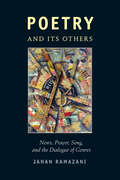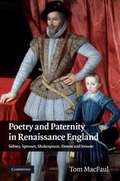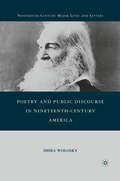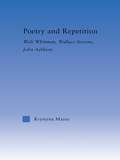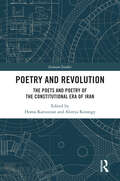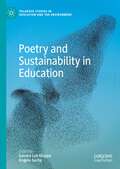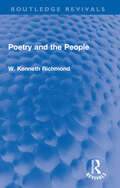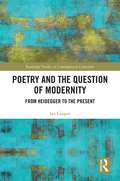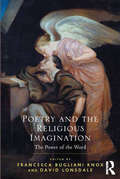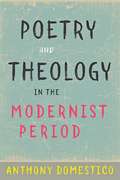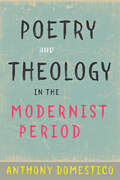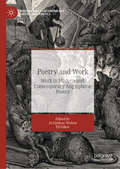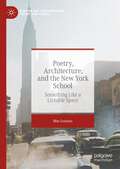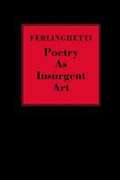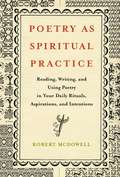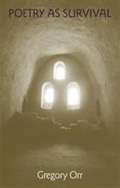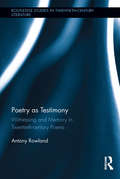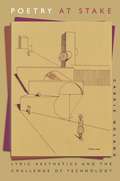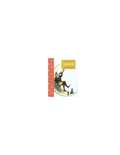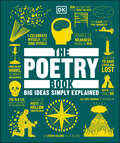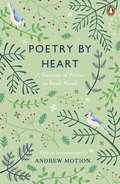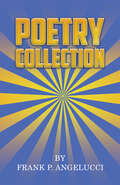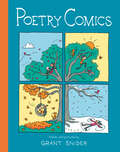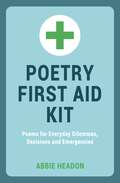- Table View
- List View
Poetry and Its Others: News, Prayer, Song, and the Dialogue of Genres
by Jahan RamazaniWhat is poetry? Often it is understood as a largely self-enclosed verbal system—“suspended from any mutual interaction with alien discourse,” in the words of Mikhail Bakhtin. But in Poetry and Its Others, Jahan Ramazani reveals modern and contemporary poetry’s animated dialogue with other genres and discourses. Poetry generates rich new possibilities, he argues, by absorbing and contending with its near verbal relatives. Exploring poetry’s vibrant exchanges with other forms of writing, Ramazani shows how poetry assimilates features of prose fiction but differentiates itself from novelistic realism; metabolizes aspects of theory and philosophy but refuses their abstract procedures; and recognizes itself in the verbal precision of the law even as it separates itself from the law’s rationalism. But poetry’s most frequent interlocutors, he demonstrates, are news, prayer, and song. Poets such as William Carlos Williams and W. H. Auden refashioned poetry to absorb the news while expanding its contexts; T. S. Eliot and Charles Wright drew on the intimacy of prayer though resisting its limits; and Paul Muldoon, Rae Armantrout, and Patience Agbabi have played with and against song lyrics and techniques. Encompassing a cultural and stylistic range of writing unsurpassed by other studies of poetry, Poetry and Its Others shows that we understand what poetry is by examining its interplay with what it is not.
Poetry and Paternity in Renaissance England
by Tom MacfaulBecoming a father was the main way that an individual in the English Renaissance could be treated as a full member of the community. Yet patriarchal identity was by no means as secure as is often assumed: when poets invoke the idea of paternity in love poetry and other forms, they are therefore invoking all the anxieties that a culture with contradictory notions of sexuality imposed. This study takes these anxieties seriously, arguing that writers such as Sidney and Spenser deployed images of childbirth to harmonize public and private spheres, to develop a full sense of selfhood in their verse, and even to come to new accommodations between the sexes. Shakespeare, Donne and Jonson, in turn, saw the appeal of the older poets' aims, but resisted their more radical implications. The result is a fiercely personal yet publicly-committed poetry that wouldn't be seen again until the time of the Romantics.
Poetry and Popular Protest
by John GardnerThis book provides provocative information on poetry written in response to the most revolutionary set of events seen in Britain since the 1640s: 'Peterloo', a peaceful protest that became a massacre; 'Cato Street', a government scripted rebellion; and the 'Queen Caroline Controversy', when the estranged wife of George IV tried to claim her crown.
Poetry and Public Discourse in Nineteenth-Century America
by Shira WoloskyArguing against the perception of poetry as an elite discourse, Shira Wolosky explores the ways that Dickinson, Whitman, Melville, and others shaped nineteenth-century American cultural debate.
Poetry and Repetition: Walt Whitman, Wallace Stevens, John Ashbery (Literary Criticism and Cultural Theory)
by Krystyna MazurThis book examines the function of repetition in the work of Walt Whitman, Wallace Stevens and John Ashbery. All three poets extensively employ and comment upon the effects of repetition, yet represent three distinct poetics, considerably removed from one another in stylistic and historical terms. At the same time, the three are engaged in a highly interesting relation to each other - a relation readers tend to explain in terms of repetition, by positing Whitman and Stevens as the two alternative 'beginnings' out of which Ashbery emerges. Krystyna Mazur analyses the work of the three poets to discern patterns that may operate across a relatively broad spectrum of examples, as well as to consider the variety of ways in which repetition can structure a poetic text.
Poetry and Revolution: The Poets and Poetry of the Constitutional Era of Iran (Iranian Studies)
by Homa Katouzian and Alireza KorangyCompiled by experts on the works of each individual poet, this book covers the poetry and poets of the Constitutional Revolution of Iran. Following a two-pronged approach, this volume studies both those who were influenced by the Constitutional Revolution in their works and those who addressed the Revolution with their work, influencing it directly. Through the analysis of their works, this volume explores influential poets and writers from the period, including Iraj, Vaziri, Afrāshteh, Yazdi, Bahār and ‘Eshqi. It covers female poets who are often overlooked, as well as the major satirical poets whose work educated and entertained the readers and criticized socio-political events. Analysing the mainstream and marginal poets, this volume argues the margins initiated the evolution of Persian poetry. As Persian poetry and its multifunctional legacy became the standard-bearer of the Constitutional movement, this volume is an important contribution to an understanding of Iran. This volume will be of interest to historians of the Constitutional Revolution and Iranian poetry, as well as to students and scholars of comparative revolutions. It is suitable for both undergraduate and graduate courses on Iranian history, Middle Eastern history and comparative studies of literature and revolution.
Poetry and Sustainability in Education (Palgrave Studies in Education and the Environment)
by Sandra Lee Kleppe Angela SorbyThis edited collection offers educators at all levels a range of practical and theoretical approaches to teaching poetry in the context of environmental sustainability. The contributors are keenly aware of the urgency facing the planet’s ecosystems—ecosystems which include all of us—and this volume makes the case that teaching poetry is not a luxury. Each of the book’s three sections works from a specific angle and register. Part I focuses on pragmatic approaches to classroom activities and curricular choices; Part II considers policies and politics, including the role of the UN’s Education for Sustainable Development (ESD) program; and Part III takes a widescreen view, exploring the philosophical issues that arise when poems are integrated into sustainability curricula. This book exemplifies how poetry empowers readers to think imaginatively about how to sustain—and why to sustain—our world, its resources, and its beauty.
Poetry and the People (Routledge Revivals)
by W. Kenneth RichmondFirst published in 1947, Poetry and the People presents a survey of English poetry from the earliest times till 1940s, viewed from an unusual angle. It is the author’s thesis that English Poetry is unpopular, in the sense that it is not loved by the people, because the sources of its inspiration, which were originally drawn from the soil, were diverted during the Renaissance into aristocratic and academic channels. Nevertheless, the emerging traditions, though driven underground, survived in the work of such men as Burns, Hogg and Clare and in folk song. This book is a must read for scholars and researchers of English poetry and English literature.
Poetry and the Question of Modernity: From Heidegger to the Present (Routledge Studies in Contemporary Literature)
by Ian CooperInterest in Martin Heidegger was recently reawakened by the revelations, in his newly published ‘Black Notebooks’, of the full terrible extent of his political commitments in the 1930s and 1940s. The revelations reminded us of the dark allegiances co-existing with one of the profoundest and most important philosophical projects of the twentieth century—one that is of incomparable importance for literature and especially for poetry, which Heidegger saw as embodying a receptiveness to Being and a resistance to the instrumental tendencies of modernity. Poetry and the Question of Modernity from Heidegger to the Present is the first extended account of the relationship between Heidegger’s philosophy and the modern lyric. It argues that some of the best-known modern poets in German and English, from Paul Celan to Seamus Heaney and Les Murray, are in deep imaginative affinity with Heidegger’s enquiry into finitude, language, and Being. But the work of each of these poets challenges Heidegger because each appeals to a transcendence, taking place in language, that is inseparable from the motion of encounter with embodied others. It is thus poetry which reveals the full measure of Heidegger’s relevance in redefining modern selfhood, and poetry which reveals the depth of his blindness.
Poetry and the Religious Imagination: The Power of the Word (The Power of the Word)
by David Lonsdale Francesca Bugliani KnoxWhat is the role of spiritual experience in poetry? What are the marks of a religious imagination? How close can the secular and the religious be brought together? How do poetic imagination and religious beliefs interact? Exploring such questions through the concept of the religious imagination, this book integrates interdisciplinary research in the area of poetry on the one hand, and theology, philosophy and Christian spirituality on the other. Established theologians, philosophers, literary critics and creative writers explain, by way of contemporary and historical examples, the primary role of the religious imagination in the writing as well as in the reading of poetry.
Poetry and Theology in the Modernist Period
by Anthony DomesticoIn this book, Domestico reveals how an important strand of modern poetry actually understood itself in and through the central theological questions of the modernist era: What is transcendence, and how can we think and write about it? What is the sacramental act, and how does its wedding of the immanent and the transcendent inform the poetic act? How can we relate kairos (holy time) to chronos (clock time)? Seeking answers to these complex questions, Domestico examines both modernist institutions (the Criterion) and specific works of modern poetry (Eliot’s Four Quartets and Jones’s The Anathemata). The book also traces the contours of what it dubs "theological modernism": a body of poetry that is both theological and modernist. In doing so, this book offers a new literary history of the modernist period, one that attends both to the material circulation of texts and to the broader intellectual currents of the time.
Poetry and Theology in the Modernist Period
by Anthony DomesticoWhat if the religious themes and allusions in modernist poetry are not just metaphors?Following the religious turn in other disciplines, literary critics have emphasized how modernists like Woolf and Joyce were haunted by Christianity’s cultural traces despite their own lack of belief. In Poetry and Theology in the Modernist Period, Anthony Domestico takes a different tack, arguing that modern poets such as T. S. Eliot, W. H. Auden, and David Jones were interested not just in the aesthetic or social implications of religious experience but also in the philosophically rigorous, dogmatic vision put forward by contemporary theology. These poets took seriously the truth claims of Christian theology: for them, religion involved intellectual and emotional assent, doctrinal articulation, and ritual practice. Domestico reveals how an important strand of modern poetry actually understood itself in and through the central theological questions of the modernist era: What is transcendence, and how can we think and write about it? What is the sacramental act, and how does its wedding of the immanent and the transcendent inform the poetic act? How can we relate kairos (holy time) to chronos (clock time)? Seeking answers to these complex questions, Domestico examines both modernist institutions (the Criterion) and specific works of modern poetry (Eliot’s Four Quartets and Jones’s The Anathemata). The book also traces the contours of what it dubs "theological modernism": a body of poetry that is both theological and modernist. In doing so, this book offers a new literary history of the modernist period, one that attends both to the material circulation of texts and to the broader intellectual currents of the time.
Poetry and Work: Work in Modern and Contemporary Anglophone Poetry (Modern and Contemporary Poetry and Poetics)
by Jo Lindsay Walton Ed LukerPoetry and Work offers a timely and much-needed re-examination of the relationship between work and poetry. The volume questions how lines are drawn between work and non-work, how social, political, and technological upheavals transform the nature of work, how work appears or hides within poetry, and asks if poetry is work, or play, or something else completely. The book interrogates whether poetry and avant-garde and experimental writing can provide models for work that is less alienated and more free. In this major new collection, sixteen scholars and poets draw on a lively array of theory and philosophy, archival research, fresh readings, and personal reflection in order to consider work and poetry: the work in poetry and the work of poetry. Individual chapters address issues such as the many professions, occupations, and tasks of poets beyond and around writing; poetry’s special relationship with ‘craft’; work's relationship with gender, class, race, disability, and sexuality; how work gets recognised or rendered invisible in aesthetic production and beyond; the work of poetry and the work of political activism and organising; and the notion of poetry itself as a space where work and play can blur, and where postwork imaginaries can be nurtured and explored.
Poetry, Architecture, and the New York School: Something Like a Liveable Space (Modern and Contemporary Poetry and Poetics)
by Mae LosassoPoetry, Architecture, and the New York School: Something Like a Liveable Space examines the relationship between poetics and architecture in the work of the first generation New York School poets, Frank O’Hara, John Ashbery, Barbara Guest, and James Schuyler. Reappraising the much-debated New York School label, Mae Losasso shows how these writers constructed poetic spaces, structures, surfaces, and apertures, and sought to figure themselves and their readers in relation to these architextual sites. In doing so, Losasso reveals how the built environment shapes the poetic imagination and how, in turn, poetry alters the way we read and inhabit architectural space. Animated by archival research and architectural photographs, Poetry, Architecture, and the New York School marks a decisive interdisciplinary turn in New York School studies, and offers new frameworks for thinking about postmodern American poetry in the twenty-first century.
Poetry As Insurgent Art
by Lawrence FerlinghettiIn 1953 Lawrence Ferlinghetti founded the first paperback bookstore in the United States. In over five decades City Lights, the bookstore and publisher, has become a Mecca for millions. Ferlinghetti's A Coney Island of the Mind (ND, 1958) is a number one best-selling volume of poetry by any living American poet. Now, New Directions is proud to publish his manifesto in a paperback edition.
Poetry as Spiritual Practice
by Robert Mcdowell"[When we read and write poetry,] it is as if a long-settled cloud in our mind suddenly dissipates, and we are divine once again." -- from the Introduction Poetry is the language of devotion in prayer, chant, and song. Reading and writing poetry creates clarity, deepens and expands spiritual inquiry, and cultivates wisdom, compassion, self-confidence, patience, and love. In author Robert McDowell's words, poetry makes you into a tuning fork of the Divine. But poetry has disappeared over the centuries from religious ceremonies, academic curricula, and public discourse. In Poetry as Spiritual Practice, the first inspirational and instructional guide to combine poetry and spirituality, McDowell restores poetry as the natural language of spiritual practice and invites you to recognize poetry as "the pure sound and shape of your spirit." Vividly illustrated with a wide range of poems from all historical eras and poetic traditions, numerous religions and faiths, and McDowell's own and his students' work, Poetry as Spiritual Practice will reintroduce you to the unique pleasure of verse. And meditations throughout will allow you to integrate reading and writing poetry into your spiritual journeys and daily life. Since many of us have long forgotten, or never learned, the mechanics and terminology of poetry -- trochaic feet and tropes trip us up; we can't tell a villanelle from its shorter cousin, rondeau; and a terza rima may as well be a tanka -- this is also an instructional handbook on reading and writing poetry. An engaging guide through the landscape of world poetry, McDowell argues along the way for the many practical benefits of poetic literacy. Making poetry an essential part of daily rituals, aspirations, and intentions will put you on the path to greater meaning, growth, and peace in your life. At once an engaging technical primer, a profound meditation on the relationship between poetry and the Divine, and an inspirational guide for integrating poetry into spiritual practice, Poetry as Spiritual Practice will become a cherished companion.
Poetry as Survival (The life of poetry)
by Gregory OrrMore specifically, he considers how the acts of writing, reading, and listening to lyric bring ordering powers to the chaos that surrounds us. Moving into more contemporary work, Orr looks at the poetry of Sylvia Plath, Stanley Kunitz, and Theodore Roethke, poets who relied on their own work to get through painful psychological experiences.
Poetry as Testimony: Witnessing and Memory in Twentieth-century Poems (Routledge Studies in Twentieth-Century Literature)
by Antony RowlandThis book analyzes Holocaust poetry, war poetry, working-class poetry, and 9/11 poetry as forms of testimony. Rowland argues that testamentary poetry requires a different approach to traditional ways of dealing with poems due to the pressure of the metatext (the original, traumatic events), the poems’ demands for the hyper-attentiveness of the reader, and a paradox of identification that often draws the reader towards identifying with the poet’s experience, but then reminds them of its sublimity. He engages with the work of a diverse range of twentieth-century authors and across the literature of several countries, even uncovering new archival material. The study ends with an analysis of the poetry of 9/11, engaging with the idea that it typifies a new era of testimony where global, secondary witnesses react to a proliferation of media images. This book ranges across the literature of several countries, cultures, and historical events in order to stress the large variety of contexts in which poetry has functioned productively as a form of testimony, and to note the importance of the availability of translations to the formation of literary canons.
Poetry at Stake: Lyric Aesthetics and the Challenge of Technology
by Carrie NolandTaking seriously Guillaume Apollinaire's wager that twentieth-century poets would one day "mechanize" poetry as modern industry has mechanized the world, Carrie Noland explores poetic attempts to redefine the relationship between subjective expression and mechanical reproduction, high art and the world of things. Noland builds upon close readings to construct a tradition of diverse lyricists--from Arthur Rimbaud, Blaise Cendrars, and René Char to contemporary performance artists Laurie Anderson and Patti Smith--allied in their concern with the nature of subjectivity in an age of mechanical reproduction.
Poetry Basics: Limericks
by Valerie BoddenAn introduction to the poetic form known as the limerick, from its origins in the 1600s to today. Example poems and analysis explore such elements as wit and nonsense.
The Poetry Book (DK Big Ideas)
by DKAn accessible guide to the most important poems ever written— from the Epic of Gilgamesh to The Waste Land—and the poets behind themDiscover the key themes and ideas behind the most important poems ever written, and the poetic geniuses who wrote them.The perfect introduction to poetry, The Poetry Book takes you on a fascinating journey through time to explore more than 90 of the world&’s greatest poetic works.Discover poems in all their many guises and from all over the world, from the epics of the ancient world through Japanese haikus and Renaissance sonnets to modernist masterpieces such as The Waste Land, and the key works of the last 50 years—from And Still I Rise by Maya Angelou to Derek Walcott&’s Omeros.Using the Big Ideas series' trademark combination of clear explanation, witty infographics, and inspirational quotes, The Poetry Book unlocks the key ideas, themes, imagery, and structural techniques behind even the most complex of poems, in clear and simple terms, setting each work in its historical, social, cultural, and literary context. Delve into the works of Dante, Baudelaire, Rimbaud, Dickinson, Eliot, and Neruda with in-depth literary analysis and fascinating biographies. Find out what odes, ballads, and allegories are. Trace recurring motifs, explore imagery, and find out how rhyme and rhythm work. From Beowulf to Seamus Heaney's Bogland, The Poetry Book is essential reading for readers of poetry and aspiring poets alike.
Poetry by Heart: Poems for Learning and Reciting
by Andrew MotionPoetry by Heart - based on the hugely successful nationwide schools competition, 200 magical poems to learn by heart'The poems we learn stay with us for the rest of our lives. They become personal and invaluable, and what's more they are free gifts - there for the taking' Simon ArmitageTwo years ago former Poet Laureate Andrew Motion had the idea of setting up Poetry by Heart - a nationwide annual competition for secondary schools which asked contestants to learn two or three poems and be judged on their recitations, first at school level, then regional, then in a national final held at London's National Portrait Gallery. It's proved a huge success, with hundreds of schools participating in the first year, and numbers up by 20% in the second. Coinciding with the start of the third year of competition, and published on National Poetry Day whose theme coincidentally in 2014 is Recitation, this Poetry by Heart anthology brings together the pool of poems - 200 altogether - from which contestants make their choices. Specially picked by Motion and his three co-editors, these poems make up a treasure house - of almost-unknown poems and familiar poems from the mainstream; love poems and war poems; funny poems and heartbroken poems; poems that recreate the world we know and poems written on the dark side of the moon. And all chosen with a view to their being recited out loud.From William Wordsworth to Wilfred Owen, Emily Brontë to Elizabeth Bishop this wonderfully enjoyable anthology will be enjoyed by all ages and includes the best poets from the past to the present day. In a groundbreaking feature, the book includes QR codes which allow readers to use their mobile phones to listen to recordings of the poems - many of them specially recorded by the poets themselves. Sir Andrew Motion was Poet Laureate from 1999 till 2009, and is Professor of Creative Writing at Royal Holloway College, London. Jean Sprackland'sTilt won the Costa Poetry award in 2008. She is a Reader in Poetry at Manchester Metropolitan University. Julie Blake is co-Founder and Director of The Full English, an organization based in Bristol which provides support to teachers of English Literature. Mike Dixon is an educational consultant specializing in English in the classroom.
Poetry Collection
by Frank P. AngelucciDelve into a poetic tapestry that weaves the myriad facets of life's journey. This collection resonates with human emotions, offering solace to souls seeking comfort and connection. Inspired by everyday moments and the indelible impact of loved ones – both present and departed – these verses are a testament to the beauty and complexity of existence. Embark on a literary voyage, and may you find as much joy in these pages as I found in penning them.
Poetry Comics
by Grant Snider“A poetry-filled graphic novel that is powerful in its simplicity.” ―Publishers Weekly, Starred Review "Personal but personable, too, with glints of quiet humor.” ―Kirkus Reviews, Starred Review “Poetry Comics is . . . a sensorial experience that taps into what it means to be human and leaves you inspired to explore, discover, create, and connect.” —Aron Nels Steinke, Eisner Award-winning cartoonist From the creator of Incidental Comics, Grant Snider, comes a fun and imaginative book that combines poetry and comics in a whole new way. Perfect for poetry lovers and reluctant readers alike.From the cloud-gazing hours of early spring to the lost bicycles of late autumn, Grant Snider’s brilliantly illustrated Poetry Comics will take you climbing, floating, swimming, and tumbling through all the year’s ups, downs, and in-betweens. He proves that absolutely everything, momentous or minuscule, is worthy of attention, whether snail shells, building blocks, the lamented late bus, or the rare joy of unscuffed shoes. These poems explore everything you never thought to write a poem about, and they’re so fun to read you’ll want to write one yourself. Not to worry, there’s a poem for that, too!FOR COMIC BOOK FANS: These poems for kids are brightly illustrated in graphic novel-style panels, adding a delightful new element to approaching poetry. Perfect for visually oriented readers and young people who already love comics, cartoons, and graphic novels.EXCITING NEW APPROACH TO POETRY: Funny, instructive, and thoroughly engaging, this poem book is a perfect addition to classroom libraries and poetry curricula. POEMS FOR EVERY SEASON: With sections for winter, spring, summer, and fall, this poetry book offers teachers and kids lots to enjoy and share all year round. SPARK A LOVE OF POETRY AND ART: Perfect for classroom writing and drawing prompts, this book will inspire readers of all ages to make and share poetry comics of their own!Perfect for:Young readers of comics and graphic novelsAspiring poets, writers, and cartoonistsParents and educators seeking a fun and engaging way to introduce kids to poetryReading and sharing during Poetry MonthReaders looking for contemporary additions to classic children's poetry like Shel Silverstein's Where the Sidewalk Ends, Falling Up, and A Light in the AtticFans of Mary Oliver looking to share an equally contemplative, nature-loving poet with kidsFans of Grant Snider books, including Nothing Ever Happens on a Gray Day, What Color Is Night?, What Sound Is Morning?, One Boy Watching, and There Is a Rainbow
Poetry First Aid Kit: Poems For Everyday Dilemmas, Decisions and Emergencies
by Abbie HeadonWhether your dilemma is something as simple as a what to have for dinner or you are trying to make a life-changing decision, the Poetry First Aid Kit has the answer. Seek a solution within these stanzas and let the enlightening limericks and illuminating iambic pentameter help you resolve the dilemmas in your life.
